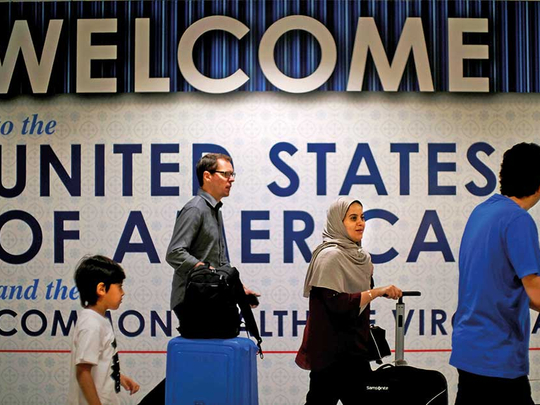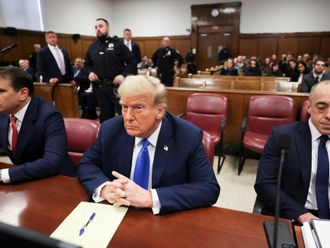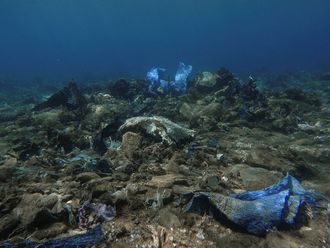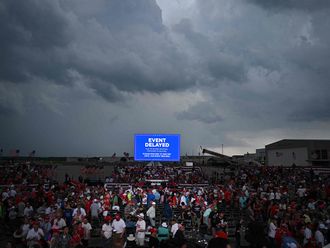
Washington: President Donald Trump’s travel ban has been partially revived by the Supreme Court, but his celebratory tweet about the decision belied his government’s confusion about how to turn the ruling into official policy.
Hours after the court acted Monday - and after Trump tweeted he was “very grateful” - federal agencies were wrestling with how to interpret and implement the justices’ will.
The court’s decision allows the government to deny entry to people from six predominantly Muslim countries who don’t have existing ties to the US - language that requires the government to figure out what it means to have a “bona fide” relationship with American residents or entities. The term isn’t defined in US immigration law.
After the court acted, the Department of Homeland Security initially referred questions to the Department of Justice, which referred questions back to DHS. State Department officials were frustrated trying to figure out how to interpret the ruling, according to three current and former officials familiar with the discussions.
“You have to take an order that at the end of the day is pretty vague and translate it into something that real people can implement, in real time,” said Leon Rodriguez, a former director of Citizenship and Immigration Services during the Obama administration who’s now a partner at Seyfarth Shaw LLP. “I can just picture the kinds of meetings that are going on.”
The State Department put out a statement Monday evening saying that it will “begin implementation” of the ban 72 hours after the Supreme Court decision.
“We will keep those traveling to the United States and partners in the travel industry informed as we implement the order in a professional, organized, and timely way,” spokeswoman Heather Nauert said.
For a Trump White House that will be back in front of justices in the fall for a more permanent ruling on the travel ban, the next few months could provide an important test. Trump’s initial foray into the travel ban clogged major US airports with confused travelers shortly after he took office. Now the administration has a chance to prove to the justices that it can implement the partial ban in an even-handed and orderly way as it argues to restore its full reach and potentially make elements of it permanent.
The State Department statement didn’t provide details on how broadly the government would interpret the ruling or who would determine whether aspiring travelers have legitimate connections to the US In addition to those seeking to travel to the US from Iran, Libya, Yemen, Somalia, Sudan and Syria, the “bona fide” relationship test must also be met by those covered under Trump’s temporary ban on refugees.
Seth Stodder, a former assistant secretary for border, immigration and trade policy at Homeland Security, said the department is better prepared than in January. But officials will struggle to translate the ruling into concrete policy implemented by thousands of consular officers and customs agents around the world, he said.
“They’re probably scratching their heads a little bit at the opinion and what to do with it,” Stodder, now a national security lecturer at University of Southern California law school, said in a phone interview.
White House spokesman Sean Spicer said the Justice Department was reviewing the decision, but declined to answer questions about the government’s next steps.
“I don’t want to get too far ahead of all of these brilliant legal minds as they review the impact,” he told reporters on Monday.
The Supreme Court agreed to consider the merits of the case in October, meaning the 90-day travel ban will expire before the high court hears arguments. The fresh uncertainty may force lower-court judges to again weigh in on the immigration fight just as hopeful visitors, immigrants and refugees believed the dispute was winding its way toward a conclusion.
Trump’s original Jan. 27 order was announced with no advance warning, resulting in some air travelers learning only after they landed in the US that they wouldn’t be let into the country. The delays and protests that erupted at airports may explain assurances issued by administration officials after the Supreme Court ruling.
“The implementation of the executive order will be done professionally, with clear and sufficient public notice, particularly to potentially affected travelers, and in coordination with partners in the travel industry,” the Department of Homeland Security said in a brief statement that struck the same themes as the one from the State Department.
Airlines most at risk of being affected by the ban continued their service as usual on Tuesday, with an immediate reaction stymied by the lack of clarity and the region’s three-day Eid al Fitr holiday.
Further complicating matters is Trump’s own distaste for the revised travel ban he signed on March 6.
“The Justice Dept. should have stayed with the original Travel Ban, not the watered down, politically correct version they submitted to S.C,” Trump said on Twitter earlier this month.
If the Trump administration seeks to enforce the Supreme Court ruling as broadly as possible, to achieve the aims of the original travel ban, the result could be additional lawsuits.
The Department of Homeland Security could issue a definition of a “bona fide” relationship, and say precisely how the travel ban will be enforced when travelers apply for visas at American embassies and consulates and arrive at US airports.
In its 13-page order temporarily allowing a portion of the travel ban to go into effect on June 29, the justices detailed some examples of a bona fide relationship. They include a foreign national who wishes to live with or visit a family member, a student who has been admitted by a university or a worker with an offer of employment from a US business.
But as Justice Clarence Thomas warned in arguing that the entire ban should have taken effect immediately, even this temporary order may prove unworkable and lead to a “flood of litigation” as US customs and border officials wrestle with whether travelers from the six countries have sufficient ties.
Courts “will struggle to determine what exactly constitutes a ‘bona fide relationship,’ who precisely has a ‘credible claim’ to that relationship,” Thomas said.












